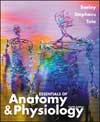 |  Essentials of Anatomy & Physiology, 4/e Rod R. Seeley,
Idaho State University
Philip Tate,
Phoenix College
Trent D. Stephens,
Idaho State University
The Respiratory System
Study OutlineFunctions of the Respiratory System
Gas exchange
Regulation of blood pH
Voice production
Olfaction
Innate immunity
Anatomy of the Respiratory System(Fig. 15.1, p. 400)Nose and nasal cavity(Fig. 15.2, p. 401)External and internal nares
Hard palate
Conchae
Paranasal sinuses
Nasolacrimal ducts
Pharynx(Fig. 15.2, p. 401)Nasopharynx
Soft palate
Oropharynx
Laryngopharynx
Larynx(Fig. 15.3, p. 402)Thyroid cartilage
Epiglottis
Vestibular folds and vocal cords(Fig. 15.4, p. 403)Epiglottis
Trachea and lungs
Trachea(Fig. 15.5a, p. 404)Lung structure(Fig. 15.5b, p. 405) Lungs
Lobes and lobules(Fig. 15.6, p. 406)Bronchioles
Alveoli
Pleural cavities(Fig. 1.12, Fig. 1.13, p. 15)Lymphatic supply
Ventilation and Lung Volumes
Changing thoracic volume(Fig. 15.7, p. 409)Muscles of inspiration
Muscles of expiration
Pressure changes and air flow
Changes in volume lead to changes in pressure
Air flows form high pressure to low pressure
Events of one respiratory cycle(Fig. 15.8, p. 409) Lung recoil -elastic forces and surface tension
Surfactant
Pleural pressure
Changing alveolar volume -follows change in thoracic volume
Pulmonary Volumes and Capacities(Fig. 15.9, p. 411)Tidal volume (about 500 mL)Inspiratory reserve volume (about 3,000 mL)Expiratory reserve volume (about 1,100 mL)Residual volume (about 1,200 mL)Functional residual capacity (about 2,300 mL)Inspiratory capacity (about 3,500 mL)Vital capacity (about 4,600 mL)Total lung capacity (about 5,800 mL)Forces expiratory vital capacity
Gas Exchange
Respiratory membrane(Fig. 15.10, p. 413)Thickness
Surface area
Partial pressure(Table 15.1, p. 414)Diffusion of gases in the lungs
Diffusion of gases in the tissues
Gas Transport in the Blood(Fig. 15.11, p. 415)Oxygen transport
Hemoglobin and oxyhemoglobin (98.5%)Dissolved in plasma (about 1.5 %) Carbon dioxide transport and blood pH(Fig. 15.12, p. 417)Bicarbonate ions (70%)Carbonic anhydrase
Relate to blood pH Blood proteins (23%)Dissolved in plasma (7%) Rhythmic Ventilation (12-20 breaths per minute in adults)Respiratory areas in the medulla oblongata(Fig. 15.13, p. 419)Two dorsal respiratory groups
Two ventral respiratory groups
Pontine respiratory group
Generation of Rhythmic Ventilation
Starting inspiration
Increasing inspiration
Stopping inspiration
Modification of VentilationClinical Focus: Respiratory Disorders p.
418
Nervous control of ventilation(Fig. 15.14, p. 420)Chemical control of ventilation(Fig. 15.15, p. 421)Medullary chemoreceptors
Peripheral chemoreceptors
Effect of exercise on ventilation
Respiratory adaptations to exercise
Systems Pathology -AsthmaSystems Interaction Table p. 425
|
|



 2002 McGraw-Hill Higher Education
2002 McGraw-Hill Higher Education